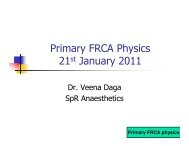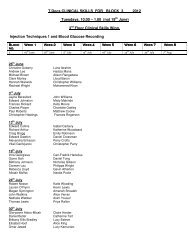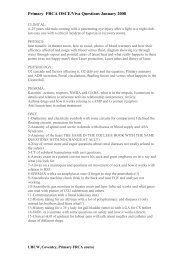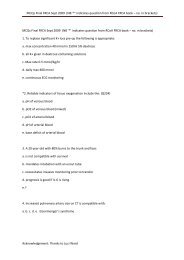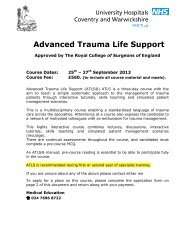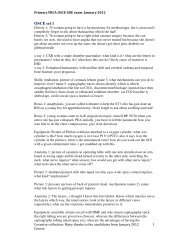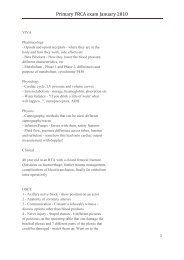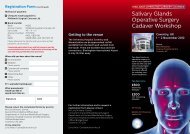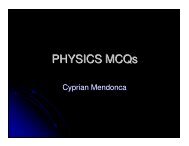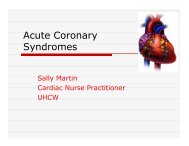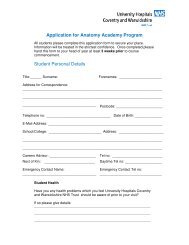Primary FRCA OSCE exam May 2012 1. X-Ray 1: severe RTA of ...
Primary FRCA OSCE exam May 2012 1. X-Ray 1: severe RTA of ...
Primary FRCA OSCE exam May 2012 1. X-Ray 1: severe RTA of ...
- No tags were found...
You also want an ePaper? Increase the reach of your titles
YUMPU automatically turns print PDFs into web optimized ePapers that Google loves.
<strong>Primary</strong> <strong>FRCA</strong> <strong>OSCE</strong> <strong>exam</strong> <strong>May</strong> <strong>2012</strong>SET 1<strong>1.</strong> X-<strong>Ray</strong> 1: <strong>severe</strong> <strong>RTA</strong> <strong>of</strong> young female, large blow right side <strong>of</strong> face, still speakingbut terrible headache. Shown a 3D reconstruction <strong>of</strong> CT head with large fracture <strong>of</strong>right side <strong>of</strong> zygomatic, orbit, frontal, etc., at least LeFort II if not more. Large arrowto infraorbital foramen on contralateral side. Questions with confounding factorsabout fractures on the healthy side (false), arrow pointing at supraorbital foramen(false) and questions about further management (needed to go rapidly toneurosurgeons). Should have been straightforward.2. X-<strong>Ray</strong> 2: CXR in recovery <strong>of</strong> a man that had laparoscopic cholecystectomy and hadlower than expected saturations all throughout the procedure. Now desaturating.X-ray looked as it had a right upper lobe collapse (there was some density withdisplacement <strong>of</strong> structures). One would think <strong>of</strong> right main bronchus intubation.Questions about the right management (should it be chest drain, antibiotics, do theyneed urgent bronchoscopy -- I could not see any foreign body). Question about whythe right hemidiaphragm is so elevated, is it because <strong>of</strong> high pressure in theabdomen.3. Equipment. Shown a photo <strong>of</strong> a scavenging device, a cylinder and asked what type<strong>of</strong> scavenging tat is and what is the pipe coming into it called. In second step shownthe same scavenging cylinder but now with something like a red flange raised on top<strong>of</strong> it. Opinated it was something like chemical scavenging that now needs to bereplenished / changed. Never seen before. Asked about concentrations deemed safe<strong>of</strong> N2O and is<strong>of</strong>lurane, one needs to know the exact numbers. Asked about who hasissued guidelines for safe levels.4. Equipment. A-line setup, to find the faults (bag not inflated, air in line (don't worryabout that, <strong>exam</strong>iner said), did not check bag, might have been dextrose or out <strong>of</strong>date, only one stopcock, tubing leaving that was IV line, connected to an IV venflon).Prompted what else is wrong with the cannula, one might think an IV cannula is plainwrong full stop, but it also was not inserted in a patient and it's lumen was kinkedand flattened and it was an 18G (green). Asked what would happen with the IVtubing (overdamping), what the reading would be. Shown a graph <strong>of</strong> the trace afterflushing with multiple oscillations (underdamping) and then on same trace a bluntedreading (overdamped) and asked why does it look like that. Asked how do wecalibrate for zero, and to show how done. Asked how we calibrate for higherpressures. Asked why if the pressure in the pressure bag is 300 mmHg we do notread that when reading the ABP, thought it was a good question and <strong>of</strong>feredunconvincing explanation.5. Resuscitation. Seen before, involves also communicating with a junior ST1, toexplain what are the actions you are doing. The ST thing puzzles one (there are noST1s, only CTs) and the ST1 is the <strong>exam</strong>iner, but they do not introduce themselves(like "I will be the ST1"). Severe asthma, intubated, admitted to ITU, now verydifficult to bag and desaturating. Leading to a pneumothorax in tension, needing tobe first noticed, then signalled as critical incident, then formally diagnosed (SimMan ICoventry collection: Many thanks to the candidates from April <strong>2012</strong> course 1
<strong>Primary</strong> <strong>FRCA</strong> <strong>OSCE</strong> <strong>exam</strong> <strong>May</strong> <strong>2012</strong>found does sound equally both sides and the <strong>exam</strong>iner says there are no sounds),then treated in emergency (they want you to puncture the SimMan), then plannedfor further management (formal chest drain, how and where the tip <strong>of</strong> tube wouldgo (upper zones), all these with explanation to the junior. The distracting factor isthat the patient deteriorates <strong>severe</strong>ly to the point <strong>of</strong> having sats in the 60s, losingany BP, and all the scaring things they can think <strong>of</strong>, but one can safely ignore thatuntil gone through all the steps at which point everything goes back to normal, orone should think <strong>of</strong> looking further (incorrect diagnosis). In a previous station thiswas anaphylaxis, so the repeating thing (hence the focus) is the communicationduring the critical incident, I would venture to say.Other distracting factor is thattube in the patient looks terribly thick like an LMA.6. Resuscitation. Station involving use <strong>of</strong> the live defib. Resus <strong>of</strong>ficer to stop you ifattempting to zap any living person. Patient collapsed and you are responding crashcall. Resuscitation in progress (resus <strong>of</strong>ficer performing feeble chest compressionsand <strong>exam</strong>iner bagging).What would you do, and then it follows through the algorithm (confirm, attach defib,rhythm check, diagnose VF). Asked if happy with chest compression and so I askedresus <strong>of</strong>ficer to compress properly and faster. Questions why do we put the padsthat way, what energy, how long the cycles, what medicines to give, if defib noteffective first few times, will we use a higher energy, they liked continuing CPR whilecharging defib, you need to demonstrate safe defibrillation. At some point <strong>exam</strong>inerstops bagging, could be a distracting factor, or could be that they didn't buy intoproper CPR mood and forgot to bag. All 2010 guidelines.7. A&E call, head injury in an elderly patient, to <strong>exam</strong>ine neurology (but not fullassessment). One has to WIPE, I would guess and then I mentioned C-spinestabilisation but <strong>exam</strong>iner got that out <strong>of</strong> the way. Proceeded to GCS, patient wouldopen eyes when spoken to and was making sense and obeying commands. Whatscore is that, if goes under 8 what would you do. Then prompted what other CNS<strong>exam</strong>ination would I do, it was about pupillary reflex to light, demonstrated, whatwould I look for (consensual, symmetry, reaction to light and accommodation), whywe look for them (raised ICP, focal neurology).8. BP measurement in live patient.Again one has to WIPE. Tell tale sign is gel at the entry / exit <strong>of</strong> station. Choose acuff, how do you choose the size, what happens if size to small, demonstrateprocedure. Patient was crossing legs, but probably because bored, one needs to sayboth sides, arms comfortable by the side. Distracting factor is that stethoscope headis turned the wrong way around and you can't hear through it. Asked the valuesmeasured, <strong>exam</strong>iner wanted to make sure he gets the values from me and checkedagainst the checklist (or ticked one way or the other). Questions about Korotk<strong>of</strong>fsounds, which one is which.9. Communication, history taking.Coventry collection: Many thanks to the candidates from April <strong>2012</strong> course 2
<strong>Primary</strong> <strong>FRCA</strong> <strong>OSCE</strong> <strong>exam</strong> <strong>May</strong> <strong>2012</strong>Patient for rhynoplasty after disfiguring car crash. As a distracting factor patient keptcomplaining <strong>of</strong> all her problems she had after the car crash so I decided on the spotto go for the easy kill and go through the routine questions (PAH, PMH, DH &allergies, SH, smoking, alcohol, teeth). I needed to wait for the patient to mentionagain once or twice the multiple problems she had after car crash and to kindly saythat I will come back to these, but could we get back to my questions. Time endedbefore we could get to the problems.10. Communication and history taking. Station was phrased the wrong way, as inhistory taking and discuss analgesia for intraabdominal hysterectomy and <strong>of</strong>ferreassurance against pain and nausea post-op. The <strong>exam</strong>iner got out <strong>of</strong> the boothduring the minute to make the point that I should focus on history taking (very kind<strong>of</strong> him). Patient concerned that she would wake up as daughter had emergency C-section and could remember things two weeks ago. Also concerned with analgesia aslast time they could not get a spinal in. Also concerned about being sick afteroperation as daughter had been very sick. During history taking it emerged that ithad been difficult to intubate her and that she had sux apnoea (and not anaphylaxis)with ITU stay few hours.Also <strong>of</strong>fered explanation about light anaesthesia for C-section, planned vs.emergency, multimodal analgesia, pain team, multimodal nausea relief butsometimes impossible to stop. Any other questions, no, patient was happy.1<strong>1.</strong> Anatomy, brachial plexus block. Standard enquiry, where does it stem from,middle trunk where does it originate from and so on. On the diagram <strong>of</strong> arm to showwhich nerves innervate which territory (this bit is blurry in my mind, forgot details).Asked which division or trunk or cord innervates the triceps muscle.12. Equipment. CO2 measurement. Shown two diagrams and asked which one is thepH electrode. Distracting factor was that they were drawn in an unexpected way,with elements thrown in the "wrong" places. Then asked on same diagrams whatdifferent elements are, electrodes (what are they made <strong>of</strong>), solutions, buffers, thelot. Probably, with this kind <strong>of</strong> distracting element the solution is to be able toexplain the electrode without following the original drawing in the books. Differentbooks show different drawings, which could be a start. One is expected to make themind up quickly, as time is limited in the station and they move on.13. Anatomy. Lung and bronchi. Asked which division is the alveolus (said 26, onehas to check the exact number, as it is required to score the point). Asked therelations <strong>of</strong> the phrenic nerve to the lung hilum. Asked what are the anatomiclandmarks <strong>of</strong> the trachaea (upper and lower). Some other details were asked.Coventry collection: Many thanks to the candidates from April <strong>2012</strong> course 3
<strong>Primary</strong> <strong>FRCA</strong> <strong>OSCE</strong> <strong>exam</strong> <strong>May</strong> <strong>2012</strong>SET 21) questions <strong>of</strong> difficult intubation− shown LC grade 3 view figure – identify the grade− what do you do to improve laryngoscopy view (not how to intubate!!)− predictors <strong>of</strong> difficult airway− how specific are the predictors− Wilson score2) resus pregnant lady, who had recent epidural + 20ml bolus− my sho colleague has inserted an epidural and gave bolus, soon after thelady became unresponsive− initial management, differentials− whom to call? (resus team, paed, obs)− what to do over and above ALS? (Intralipid, C-sect)− Intralipid regime doses <strong>of</strong> boluses, infusion3) anatomy diaphragm/muscles <strong>of</strong> ventilation− identify usual structures− at what vertebral level do structures cross− what is the innervation <strong>of</strong> the diaphragm (it seemed the roots C345 were alsomarked)− what do you see on the CXR in case <strong>of</strong> pherinc n. paralysis−4) communication 14yo boy walked out <strong>of</strong> theatre you have to talk to mom aboutconsent, whether they can force the son into having the op.− not sure was it Gillick competence?− Mom wants the boy to have the op− at home boy agreed to have it, signed the consent himself(!)− the boy's friends have told him things like being awake through the op, andthen not waking up− your consultant is talking to the boy at the same time as you chat to themother− Mom wants to know whether the boy can have the op on the day or later,brings up the issue how difficult it is to organise A/L and bring the child5) chest drain− basically the bottle only and complications with it− identify the bits like drain, bottle, suction− how deep should the end <strong>of</strong> the drain be under water− what happens if it is 15cm below water level− where should the bottle be in relation to the patient− what happens if the bottle is above the patient− what happens if there is fluid left in the drain tube− what happens if the drain is clamped6) skills? pre-assess term lady for GA and spinal/epidural. New station supposedlyCoventry collection: Many thanks to the candidates from April <strong>2012</strong> course 4
<strong>Primary</strong> <strong>FRCA</strong> <strong>OSCE</strong> <strong>exam</strong> <strong>May</strong> <strong>2012</strong>test? Had toexplain what would I do, what <strong>exam</strong>ination or test I'd perform?− this probably was a test station I guess, never seen or heard <strong>of</strong> such station− actor with pillow over her tummy− guidance is to demonstrate how you pre-assess her for an elective C-sect− for both spinal/epidural and GA− had to talk to her and take brief Hx,− demonstrate a quick airway assesment− demonstrate how you'd assess back, show where you'd put spinal− contraindications for spinal− I don't quite remember what, but she had some problem which made the GAto be difficult7) sorry can't remember8) history− 54yo M for v/v.− asthmatic, one itu adm at age <strong>of</strong> 10 secondary to propranolol, otherwise wellcontrolled well controlled.− no allergies.− Had GA once in past - OK9) resus few days post-op patient− ecg shown <strong>of</strong> asystole− witnessed in-hospital collapse− nurses already giving bls− what do you do first− what do you do next− Hs and Ts− differential for collapse10) XR Hx <strong>of</strong> a lady coming for other surgery, complaining on occasional neckswelling and regurgitation <strong>of</strong> undigested food− neck XR x3, at different stages <strong>of</strong> swallowing ?barium− pharyngeal pouch− is this a static test?− Is RSI compulsory?11) XR 3D reconstruction <strong>of</strong> spine CT (12 th rib visible, app. T12-L3) Hx <strong>of</strong> trauma, Ptfell down from height, now can't move legs from below knee and has loss <strong>of</strong>sensation too on one side up to the groin− #L1 causing spinal compression− are thoracic vertebrae visible?− Are L2-3 roots intact?− On turning, can this patient have spinal shock?12) sim, malignant hyperthermia had to ask for tempertature probe. once had a clueCoventry collection: Many thanks to the candidates from April <strong>2012</strong> course 5
<strong>Primary</strong> <strong>FRCA</strong> <strong>OSCE</strong> <strong>exam</strong> <strong>May</strong> <strong>2012</strong>have been pushed though very quickly by <strong>exam</strong>iner− the ventilator didn't work on the sim! So you go there to find a high etCO2patient not actually ventilated, but having a CO2 trace...13) skills spinal− show on actor and explain how it is done?− Anatomy, why that space?− which needle I'd use and why?− How much <strong>of</strong> what drug?14) history Lady for MTP replacement sec to RA tells at the end she's got bronchitis,but when asked if she has any breathing problems she denies. Why?15) monitoring oesophageal temp probe− what exactly is the semi-conductor made <strong>of</strong>?− What is core temperature?− 3 ways <strong>of</strong> heat loss in theater− how can you stop radiation heat loss?16) anatomy CN X− where are the nuclei,− what does it innervate− under what clinical (not pathological) circumstances might you come acrossbrady?− What can you do about it?17) check Bain circuit,− anaesth machine: Fabius (not Fabius Tiro)− couldn't see any visual problems on the circuit− many had problems finding the O2 flush for the tests (inc. me), <strong>exam</strong>inerdidn't help− what is the volume <strong>of</strong> the outer tubing, and why?− what happens if the reservoir bag gets disconnected?− inner tube was damaged, failed the tests− would it be safe to use this circuit?17.) Blood transfusionChecks, what do you prescribe, transfusion reactions-signsComplications <strong>of</strong> transfusionSET 3<strong>1.</strong> Right IJV imaging with ultrasound, theory <strong>of</strong> ultrasound2. Sidestream capnography, comparison <strong>of</strong> two sample lines; one small diameter,one large. 3 capnograph traces.Coventry collection: Many thanks to the candidates from April <strong>2012</strong> course 6
<strong>Primary</strong> <strong>FRCA</strong> <strong>OSCE</strong> <strong>exam</strong> <strong>May</strong> <strong>2012</strong>3. Communication: Afro-Caribbean pt, scheduled for arthroscopy. No bloodsavailable. Turns out he is needlephobic, has refused FBC and sickle cell bloodtests. Ideas, concerns, expectations, reach mutual decision with pt to cannulateand take bloods at the same time on ward using EMLA, cold spray and distractiontechnique; a good-looking nurse did the trick, (the patient’s words, not mine!!).4. Management <strong>of</strong> VT5. Defibrillation station, AF6. Needlestick management7. Cervical X-ray: Trauma patient, fall <strong>of</strong> motorbike. # second vertebrae, sensorysymptoms in hands.8. CT Head: extradural haematoma.9. Critical incident: RSI’d pt for mid-shaft femur # ORIF, go in to help the SHO. Satsdrop, tachycardia, low etCO2, low BP. No rash. 100% O2, ask for help, fullassessment, resolves with metraminol; likely fat embolus, (not anaphylaxis!)10. DINAMAP, principles <strong>of</strong> oscillilometry. (This may have been the test station, as itwas only 8 questions long and finished in 2 minutes…)1<strong>1.</strong> Respiratory <strong>exam</strong>ination, forgot whispering pectoriloquy but was prompted.12. Pre-op assessment: Pt for ‘nose op’. It is septorhinoplasty, pt has sleep apnoea,high blood pressure on nifedipine, few other usual bits. Cheekily, they didn’t givethe patient’s age and I realised at the end; asked, and saw the <strong>exam</strong>iner rub out aprevious cross on the mark sheet and correct it!13. Pre-op assessment: Mastectomy, family history <strong>of</strong> MH but patient has beentested and is negative. On iron, has had chemo. Allergy to iodine scrub andelastoplast. Usual assessment otherwise.14. Spinal anatomy: not <strong>of</strong> the spinal cors, asked predominantly about the ligaments,joints, start and finish <strong>of</strong> the cord, a bit about CSF; pretty horrible station! Thequestions were quite hard to follow, seemed quite cumbersome; I wonderwhether this might have been the test station? (or am I just hoping… !)15. Machine Check: Back-bar leak, no blanking plugs on empty cylinder yolks, oxygenanalyser not working. It said in the information that marks would be given for asystemic approach.16. Airway management: Demonstrate bagging a mannekin with a BVM, talk aboutNPA.Ankle blocks: anatomy, nerve supple, demonstration <strong>of</strong> technique17. Cvp line insertion- nice guidelines on why USs use better than landmarktechniqueSET 41) scavenging and the various bits and pieces associated with this, whatthe pink floating thing is2) 2 resuscitation stations first ALS, the first one you have to tell theparamedic to do compressions properly. asked about what energy fordefibrillation, asked what to do if adrenaline and amiodarone dont workfor refractory vf (lidocaine - asked about dose <strong>of</strong> lidocaine)Coventry collection: Many thanks to the candidates from April <strong>2012</strong> course 7
<strong>Primary</strong> <strong>FRCA</strong> <strong>OSCE</strong> <strong>exam</strong> <strong>May</strong> <strong>2012</strong>3) brachial plexus and all the branches. very specific questions aboutwhich nerves supply which muscles4) history taking, lady with ank spond for emergency c section5) art line set up and finding the fault (green canula used, compliant ivfluid tubing, bubbles in tube, glucose instead <strong>of</strong> saline (asked what thismay cause), then questions about zeroing. then question about how do youzero for high pressure. then showed an underdamped trace and asked howthis would affect readings.6) bp measuring station, asked to measure bp using the right size cuff onan actor. then asked questions about bp how it changes with age and how towork out MAP and why the equation for MAP is what it is7) x ray <strong>of</strong> ull collapse in a post colectomy patient. then some questionsabout colitis and zinc deficiency in colitis, whether you need steroidsfor patient who has had predsol enemas, whether u can give sulphasalazinein someone who is allergic to sulphonamides8) reconstructed ct face <strong>of</strong> a patient with a nasty facial fracture9) asthma and tension pneumothorax station10) insertion <strong>of</strong> subclavian line using landmark technique, name 6immediate complications711) ph electrode diagram and how it works12) history taking for rhinoplasty13) communication for patient whose family member had awareness duringprev anaesthetic and now they are worried that they may have it also14) lung anatomy - anatomical boundaries <strong>of</strong> trachea, course <strong>of</strong> the phrenicnerve, piercings throught the diaphragm, sensory supply to trachea, whichbronchus after carina is closest to carina15) assessment <strong>of</strong> gcs and then questions about pathway <strong>of</strong> light reflex16) diathermy and electrical safety station. picture <strong>of</strong> 2 circuits andthen 2 points labelled on both circuits and asked which point is it ok totouch if patient is earthed. patient toucing metal pole during use <strong>of</strong>diathermy and asked what would happen. asked about small diathermymonopolar pad and asked exactly what is it called and why you would getburns if you put a paediatric pad on an adult patient. asked aboutCoventry collection: Many thanks to the candidates from April <strong>2012</strong> course 8
<strong>Primary</strong> <strong>FRCA</strong> <strong>OSCE</strong> <strong>exam</strong> <strong>May</strong> <strong>2012</strong>pacemaker and asked what a vvi pacemaker means and then what effect thediathermy would have on demand pacemakerSET 5Asthma patient -SimMan Tension pneumothoraxHistory Preop RhinoplastyAnatomy -Trachea,phrenic nerve,diaphragmPh -MeterInvasive arterial BP Find the faults in the set,method <strong>of</strong> calibration zeroingVF algorhythmX-rays-Post op RT upper lobe collapse and maxill<strong>of</strong>acial traumaNIBP - MeasurementHistory Labor AnalgesiaReassurance AwarenessBrachial plexusDiathermyScavengingHead Injury Patient assessmentSET 6• 2 diagrams are shown, which one describes the pH electrode and asked tolabel the diagram.• using anaeroid sphygmomanometer to measure BP on a subject. which cuffto choose and why and question about Korotkov sounds.• A CXR showing what I think Rt upper lobar collapse for a patient hadcolectormy for colitis and had postoperative hypoxemia. Questions: thispatient must receive antibiotics, aspiration is probable cause, this pt wasshowing low oxygen saturation intaraoperativel, rigid bronchoscpy must bedone immediately, zinc deficiency causes colitis, sulfasalazin iscontraindicated in patients with sulphonamide allergy. patient receivingpredesol enema should receive corticosteroid replacement.• A 3D reconstruction image <strong>of</strong> patient's face following motor car accidentafter hitting scaffolding.• History taking from a patient at the preanaesthesia clinic for painless labourepidural (history reveals that she has ankylosing spondylitis)• History taking from a patient scheduled for rhinoplasty (history reveals thatshe had a problem with suxamethonium during previous splenectomy)Coventry collection: Many thanks to the candidates from April <strong>2012</strong> course 9
<strong>Primary</strong> <strong>FRCA</strong> <strong>OSCE</strong> <strong>exam</strong> <strong>May</strong> <strong>2012</strong>SET 7• Communication with a patient scheduled for laparoscopic tubal ligation whosuffers motion sickness and her daughter had awareness while havingcesarean section.• Simulation <strong>of</strong> safe defibrillation for VF, questions about level <strong>of</strong> energy andALS alogarithm .• Checking a set line and transducer <strong>of</strong> invasive BP monitoring , shown a photo<strong>of</strong> square wave test and its interpretation.• Anatomical landmark approach to insert a subclavian vein line using Seldingertechnique.• Anatomy <strong>of</strong> trachea lung and diaphragm, what are the upper and lowerboundries <strong>of</strong> trachea, sensory innervation <strong>of</strong> trachea. level which tracheareaches during inspiration . What is the nearest lobar bronchus to thetrachea? Afferent <strong>of</strong> pulmonary stretch receptors, Root value <strong>of</strong> phrenicnerve and its relation to the hilum <strong>of</strong> the lung.• Assessment <strong>of</strong> trauma patients ( questions typically about GCS anddemonstrate manual neck stabilization and pupil <strong>exam</strong>ination ).• Photos <strong>of</strong> an anaesthetic gases receiving system , questions aboutdifferences between active an passive scavenging systems, recommendations<strong>of</strong> maximum levels <strong>of</strong> theater pollution.• critical incident: a case <strong>of</strong> tension preumothorax and performing needledecompression.• Anatomy <strong>of</strong> brachial plexus. Which sympathetic ganglia share to the brachialplexus? what is the nerve supply <strong>of</strong> the triceps muscle? relations <strong>of</strong> thebrachial plexus cords to the axillary artery. Where does lateral cutaneousnerve <strong>of</strong> the forearm comes from?• ECG: a strip showing VF and again questions about ALS management.<strong>1.</strong> History• Take a history from a young female having a Hickman line inserted• Had a history <strong>of</strong> leukaemia and her previous line had beeninfected• Pt looked very nervous – on asking specifically why, she said shehad needle phobia and asked for reassurance she wouldn’t haveto have a needle for inductionCoventry collection: Many thanks to the candidates from April <strong>2012</strong> course 10
<strong>Primary</strong> <strong>FRCA</strong> <strong>OSCE</strong> <strong>exam</strong> <strong>May</strong> <strong>2012</strong>2. History• Take a history from a female having a cholecystectomy• Previous acute cholecystits• There was a vague history <strong>of</strong> a cousin having problems withanaesthetics and needing testing. I asked about whether she orher parents/siblings had needed testing, she said no. Did not havetime to get to PMH but I don’t think she had anything specific.3. Communication• 50 year old man has come in for pre-op assessment for inguinal herniarepair. He has had some chest pain and the nurse would like you to talk tohim.• This was a difficult station as it was stated as communication but I wasn’tsure what I was supposed to communicate. I spent most <strong>of</strong> the 5 minsactually getting a history about the chest pain and risk factors for IHD(smoker, brother died <strong>of</strong> MI). I then explained that it was important toexclude MI/Angina and that we would need to do an ECG/Obs and get ptto A+E. Explained that it would be safer for him not to have the operationuntil we had a diagnosis4. Exam• Examine pt’s jugular venous pressure• Examined JVP on actor and then answered questions on CVP trace e.g.what causes a and c wave. When would JVP be raised. When would youget large v waves5. Anatomy• Anatomy <strong>of</strong> spinal cord• Initially asked about how many mls <strong>of</strong> LA needed to block each segment ifdoing a lumbar epidural. Then volume and specific gravity <strong>of</strong> CSF.• Asked to name labelled tracts (combination <strong>of</strong> ascending and descendingtracts). Blood supply <strong>of</strong> spinal cord. Origin <strong>of</strong> anterior spinal artery andwhat would happen if artery was thrombosed6. Technical Skills• Tracheostomy tube change• Asked what pre-preparation is required then to demonstrate it onmanikin. Asked about complications7. Technical Skills• Ankle Block• Asked about the nerves that supply th foot and their distribution (had todemonstrate on actor). Then asked to demonstrate on actor how I wouldblock the tibial nerve, deep peroneal nerve and how many mls8. Technical SkillsCoventry collection: Many thanks to the candidates from April <strong>2012</strong> course 11
<strong>Primary</strong> <strong>FRCA</strong> <strong>OSCE</strong> <strong>exam</strong> <strong>May</strong> <strong>2012</strong>• Caudal block in a 5 year old having an orchidectomy• Shown a bony model <strong>of</strong> sacrum. Asked to name sacral hiatus and whatcovers it. Demonstrate how you would perform the caudal block onmodel. Max dose <strong>of</strong> bupivicaine and if the child weighs 20kg, max volume<strong>of</strong> 0.25% bupivicaine that can be given. Complications <strong>of</strong> block. What youwould look/ask about before sending child home.9. Equipment• O2 Cylinders• Shown a photo <strong>of</strong> size E O2 cyliinder. Asked what it is made <strong>of</strong>, pressure,why it cannot be used in MRI, what does tare weight mean. What is thepressure in a N2O pipeline supply.• Shown a bodok seal, asked what it was called, why is it needed.• What safety features are present on anaesthetic machine to ensurecorrect gas exits common gas outlet. What are the internal/externaldiameters <strong>of</strong> the common gas outlet.10. Equipment• O2 analysers• Shown 3 photos <strong>of</strong> fuel cell/Clark’s/Paramagnetic• Asked which one was the polarographic electrode, then had to labeldiagram. Given 4 different equations and asked which one occurred atthe cathode. What is the voltage.• Identified 1 st photo as fuel cell. Asked about its components1<strong>1.</strong> Equipment• CO2 side stream analyser• Given a bain circuit + HMEF, asked to connect side stream analyser toHMEF. There were 2 different sized tubings, I picked the smaller one. Wasasked how the larger tubing would affect CO2 measurement, why theanalyser is attached to the inspiratory port <strong>of</strong> the HMEF rather than theexpiratory port and what effect it would have on CO2 measurement ifattached to expiratory port. Shown capnograms <strong>of</strong> rebreathing andairway obstruction. Asked specifically what the abnormality was and thenthe cause (so e.g. had to say the upward slope is flatter, indicating airwayobstruction)12. Resus• 15 year old boy found in lake, CPR ongoing• Continued CPR, attached defibrillator leads, diagnosed VF and thenshocked model• Then asked why might the pt not be responsive to DCCV (i.e.hypothermic) and how would you increase the temp. What would you doCoventry collection: Many thanks to the candidates from April <strong>2012</strong> course 12
<strong>Primary</strong> <strong>FRCA</strong> <strong>OSCE</strong> <strong>exam</strong> <strong>May</strong> <strong>2012</strong>13. Resusif no response after 3 shocks ( I said rewarm first before shocking again).What drugs would you give• Called to see a post op patient in recovery who has a low BP• Shown an ECG <strong>of</strong> bradycardia. Asked to identify abnormality, initialtreatment, risks <strong>of</strong> asystole. What would you do if remains unstable (saidI would contact cardiologist for transvenous pacing)14. SimMan• Junior anaesthetist has called you because their patient is hypertensive• Assessed ABC quickly, pt tachycardic and hypertensive. Inspiredsev<strong>of</strong>lurane low. Stated that I would give a bolus <strong>of</strong> prop<strong>of</strong>ol, deepenanaesthesia (increase FGF and volatile), give opioid.• Asked what I would do if remained tachycardic and hypertensive, causes,what other agents could be used for hypertension, MAC <strong>of</strong> sevo.15. Hazards• Discussion about blood transfusions• Asked what the current guidelines are in relation to writing a prescriptionfor blood products and then what needs to be checked before giving ablood product. What are you looking for when inspecting the bag. 2 mostcommon complications associated with blood product transfusions.When blood is taken from the blood bank, within what time frame does itneed to be started and completed.16. Radiology• C spine x ray <strong>of</strong> male with history <strong>of</strong> <strong>severe</strong> arthritis needingappendicectomy• There was an obvious abnormality around the transverse process areas –very fuzzy, indistinct. I had no idea what it could be. The verterbral bodiesdid not have the typical ‘bamboo’ spine you get in ank spond. Questionsasked HLAB27 / aortic regurg / complete heart block is associated withthis condition. Whether the patient would have difficult mouth opening.If a regional block would be indicated.17. Radiology• CT chest <strong>of</strong> a man with 30% burns to lower limbs• Showed a pneumothorax. Asked if a chest drain should be inserted;whether suxamethonium can be used; if pt weighed 70kgs, if fluidreplacement should be 8 L over 24 hours; if there was an inhalationalinjury; if intubation was needed urgently; if cardiothoracic ratio wasenlargedCoventry collection: Many thanks to the candidates from April <strong>2012</strong> course 13
<strong>Primary</strong> <strong>FRCA</strong> <strong>OSCE</strong> <strong>exam</strong> <strong>May</strong> <strong>2012</strong>SET 81) Ankle Block: nerve supply to foot, Course <strong>of</strong> saphenous nerve, position <strong>of</strong>posterior tibial nerve, Deep peronial nerve, show the area <strong>of</strong> supply <strong>of</strong> lateralplantar nerve, maximum Dose <strong>of</strong> bupivacaine, lignocaine & prilocaine with orwith out adrenaline.2) Assemble bain circuit with HME & side stream CO2 analyser, what areadvantages <strong>of</strong> CO2 analyser on machine side, showed a big wide tube askedwhether we can use this for analyzing CO2, where do you think end tidalvalues will be more on machine end or pt end <strong>of</strong> HME. Graphs <strong>of</strong> ETCO2.3) Communication:pt scheduled for Inguinal hernia repair pre-op nurseconcerned as pt C/O chest pain- convince the pt for postponing operstion forcardiac investigations.4) History-Lap chole , cousin was admitted to hospital after casarian section dueto anaesthetic reaction.5) History- Hick man line under GA as pt is needle phobic.6) Anatomy <strong>of</strong> spinal cord-Identify different tracts, course <strong>of</strong> pyramidal tracts,anterior spinal artery syndrome, blood supply <strong>of</strong> spinal cord.7) Oxygen cylinder- pressure <strong>of</strong> cylinder when full, what does tare weightrepresent, what is it made <strong>of</strong>, can we use this in MRI scanner, what are safetyfeatures to prevent wrong gas coming out <strong>of</strong> common gas oulet.8) Examination <strong>of</strong> JVP- position <strong>of</strong> pt, how do you measure, how can you make itprominent(hepato jugular, valsalvar maneuver), which phase <strong>of</strong> respiratorycycle you measure it, what causes a wave, what is cause <strong>of</strong> C wave ,when isJVP increased, when is A wave disappeared &when is it prominent, reasonsfor gaint V wave.9) Resus- sinus bradycardia-ECG, when do you say pt is unstable, what will youdo, risks <strong>of</strong> asystole, who will do transvenous pacing.10) Resus- 15yr old cardiac arrest following fall from ice skating on goingBLS, safe defib, I was bit confused to use adult or paediatric algorithm.Temp 37, management.11)Siman-post induction tachycardia &hypertension, check endtidal values,what is MAC <strong>of</strong> sev<strong>of</strong>lurane, measures to treat tachycardia- analgesicsbetablockers, nitrates, vasodilators, muscle relaxatanta if weaning.12) Technical skills-caudal block, anatomical landmarks, where does duraCoventry collection: Many thanks to the candidates from April <strong>2012</strong> course 14
<strong>Primary</strong> <strong>FRCA</strong> <strong>OSCE</strong> <strong>exam</strong> <strong>May</strong> <strong>2012</strong>End in paediatric age group, procedure , complications <strong>of</strong> caudal block,Max volume <strong>of</strong> bupivacaine 0.25% for child weighing 20kg. when do youdischarge this child.13) Technical skills- Tracheostomy tube change for pt who had tracheostomy 15days back, prerequsites before changing tube, complications <strong>of</strong> tube changeapart from false track, what will you do if you failed to insert tube back ,demonstrate the technique.14)X ray Cervical spine lateral view, honestly did not fig out what was problem ,it is X-ray <strong>of</strong> 40yr old man for emergency appendix surgeryques-can this man have diificulty in intubation, is spinal appropriate technique,can he be positive for HLAB27 antigen,can you see all cervical disc spaces.15) CT abdomen <strong>of</strong> 60yr old man who sustained 30% burns on lower legs after fullmeal ,surgeons did CT scan as his chest X-ray was abnormal, Scan showedLt sided Pneumothorax. Q-does this pt need lt sided chest drain, is sux contraindicated, Fluclaxacillin preferred antibiotic for Staff.aureus, does he poses risk <strong>of</strong>aspiration.16) Anaesthetic equipment- O2 analyser, three diagrams Identify which one isFuel cell, showed different reactions asked to identify which one happens at cathode,what are the electrodes made <strong>of</strong>f, what is the electrolyte, what is voltage inpolarographic electrode, what is it used for other than O2 analysis in gas mixture, Isaid-O2 in blood sample, how do you calibrate O2 analyser, there was one morephotograph <strong>of</strong> paulings analyser asked to identify it.17)Anaesthetic hazards- Blood transfusion, what would you document beforetransfusing blood, what would you check before transfusing, within what time scalethe blood should be transfused after taking from blood bank fridge, what timetransfusion should be completed once it has started, what are clical features <strong>of</strong>transfusion reaction under anaesthetics.SET 9Anatomy+Diaphragm – central tendon,insertion, innervation, sensory, motor,+Vagus – origin, jugular foramen,functions, laryngeal innervation, plexus, role inclinicalanaesthesiaCommunication+14 yo Child freaked out in anaes room,for hernia op, consultant gone to see child,Coventry collection: Many thanks to the candidates from April <strong>2012</strong> course 15
<strong>Primary</strong> <strong>FRCA</strong> <strong>OSCE</strong> <strong>exam</strong> <strong>May</strong> <strong>2012</strong>please go talk tomother, answer relevant questions. Asked about use <strong>of</strong> force,overridingthe consent form signed by child, told that she took time<strong>of</strong>f work, etc. plan forfuture ?Xray+Lumbar CT – builder fell 20 feet,broken both tib, plus one femur. Asked questionson fluids, spinalshock, etc+Ba Swallow – pharyngeal pouch,askedquestions on diagnosis, and management,and anaes implicationsALS:+asystole- how to proceed, what to do,drugs to use, when to use bicarbSimulation:+MH – PaCo2 <strong>of</strong> 7.8, told it was abt 5in anaes room, asked about management andtests.Resus:+high spinal vs LA toxicity. Pregnant,20mls <strong>of</strong> 0.5% chirocaine in epidural catheter,LOC, start ALS, thentalked abt high spinal and la toxicity managementEquipments:+Temp Probe: nasal temp probe, graphs,methods <strong>of</strong> heat lossAnaes Equipment+Machine check-bain circuitPhysical Exam:+<strong>exam</strong>ine patient for suitability <strong>of</strong> GAvs Epidural vs Spinal for LSCSTechnical skills:+spinal – show how to find space, whysafe in that space. What needle would youuse? Why?+Chest drain – features, safety,level <strong>of</strong> tube below water, level <strong>of</strong> bottle from chestHistory:Coventry collection: Many thanks to the candidates from April <strong>2012</strong> course 16
<strong>Primary</strong> <strong>FRCA</strong> <strong>OSCE</strong> <strong>exam</strong> <strong>May</strong> <strong>2012</strong>+54 needing varicose veins stripping,had multiple allergies, heart problem+old lady needing hand surgery for RA,lobectomy due to tb, etc+Airway assessment, Cormack and lehanegrade, what would u use to improve,oesophageal intubation co2 trace,SET 101) Historyassessment pt with breast Ca,, scheduled for mastectomy. Post chemo andradiotherapy, had lumpectomy afterwards PONV, concerned whether she will feelsick again, reassured and told her about prophylaxis2) x-ray cervical spine20yr old motor cycle driver after <strong>RTA</strong>questions:C2 fracture,?longitudinal muscle injury?is he a level 1 transfer?3) CT HEAD, 63 yr after fall from bicycle, on admission drowsy, but obeys allcommands, after 20mins reduced conscious level?Questions:subdurual haematoma left?Immediate intubation on admission appropriate?Needs immediate surgery?temporal fracture R?4) SIMtrauma pt, after RSI, taking over from ST1pt tachycard, hypotensive, on N2O, Sevo and O2,responds to fluid challenge and vasoconstrictorsdifferential diagnosis, I think they wanted to hear fat embolus.5) AirwayBMV: what manoeuvers to improve positions, demonstrate on mannequin, give 5breathsWhat would you do differently with an 8kg childNasopharyngeal airway: what are the complications using it? Contraindications?6) MeasurementNon-invasive BP measurementPicture <strong>of</strong> DINAMAP monitor, what is the principle behind? Is it directly measured orcalculated? Would a BP measurement <strong>of</strong> 170/150 physiologically possible? Why not?7) HistoryCoventry collection: Many thanks to the candidates from April <strong>2012</strong> course 17
<strong>Primary</strong> <strong>FRCA</strong> <strong>OSCE</strong> <strong>exam</strong> <strong>May</strong> <strong>2012</strong>septoplasty, middle aged pt, OSA, seen GP, <strong>severe</strong> snoring, seen GP supposed to haveCPAP, drinks alcohol once/day, ex-smoker, 40 pack years, stopped 5 yrs ago, put onweight afterwards. GORD, occasional Gaviscon, but woke up once/twice with funnytaste in the mouth, on treatment for HTN (nifedipine)8) AnatomySpinal cord, where does it end in adults, infants? What is the end <strong>of</strong> cord called (Filiterminalis) Lateral support structure dura mater?Show on model:What is structure A and B (Atlas and Axis)?Structure C? (odontoid)where do thoracic spinal roots leave (structure)?where is the lamina and peduncles on lumbar vertebra?9) Anaesthetic machinenew machine, not familiar with it. Only machine check, marks for systematic check(there was no monitor, no O2 analyser, scavenging or any auxiliary equipment)no N2O or air cylinder, vaporisor empty, there was a leak, but could not find it.10) CVP LineFrequency <strong>of</strong> US, what probe?Show IJV and carotid, how would you distinguish (3 factors)?Name the advantages <strong>of</strong> US use listed in NICE guidelines11) Communication20yr old Afro – carribean pt, for arthrocopy, surgeons want to use tourniquet, noblood test for sickle cell yet, needle phobic12) ExaminationAsthma and chronic COPD, <strong>exam</strong>ine respiratory system,what is whispered pectoriloquy?what does FEV1/FVC tell?13) ResucitationRhythm strip, narrow complex tachycardia, what would you do?Why these paddle positions?Demonstrate synchronized shock, what energy?demonstrate anterior/posterior paddle positionsSET 11Ankle Block: nerve supply to foot, Course <strong>of</strong> saphenous nerve, position <strong>of</strong> posteriortibial nerve, Deep peronial nerve, show the area <strong>of</strong> supply <strong>of</strong> lateral plantar nerve,maximum Dose <strong>of</strong> bupivacaine, lignocaine & prilocaine with or with out adrenaline.Assemble bain circuit with HME & side stream CO2 analyser, what are advantages <strong>of</strong>CO2 analyser on machine side, showed a big wide tube asked whether we can use thisCoventry collection: Many thanks to the candidates from April <strong>2012</strong> course 18
<strong>Primary</strong> <strong>FRCA</strong> <strong>OSCE</strong> <strong>exam</strong> <strong>May</strong> <strong>2012</strong>for analyzing CO2, where do you think end tidal values will be more on machine end orpt end <strong>of</strong> HME. Graphs <strong>of</strong> ETCO2.Communication:pt scheduled for Inguinal hernia repair pre-op nurse concerned aspt C/O chest pain- convince the pt for postponing operstion for cardiacinvestigations.History-Lap chole , cousin was admitted to hospital after casarian section due toanaesthetic reaction.History- Hick man line under GA as pt is needle phobic.Anatomy <strong>of</strong> spinal cord-Identify different tracts, course <strong>of</strong> pyramidal tracts, anteriorspinal artery syndrome, blood supply <strong>of</strong> spinal cord.Oxygen cylinder- pressure <strong>of</strong> cylinder when full, what does tare weight represent,what is it made <strong>of</strong>, can we use this in MRI scanner, what are safety features toprevent wrong gas coming out <strong>of</strong> common gas oulet.Examination <strong>of</strong> JVP- position <strong>of</strong> pt, how do you measure, how can you make itprominent(hepato jugular, valsalvar maneuver), which phase <strong>of</strong> respiratory cycleyou measure it, what causes a wave, what is cause <strong>of</strong> C wave ,when is JVPincreased, when is A wave disappeared &when is it prominent, reasons for gaint Vwave.Resus- sinus bradycardia-ECG, when do you say pt is unstable, what will you do, risks<strong>of</strong> asystole, who will do transvenous pacing.Resus- 15yr old cardiac arrest following fall from ice skating on goingBLS, safe defib, I was bit confused to use adult or paediatric algorithm.Temp 37, management.Siman-post induction tachycardia &hypertension, check endtidal values,what is MAC <strong>of</strong> sev<strong>of</strong>lurane, measures to treat tachycardia- analgesicsbetablockers, nitrates, vasodilators, muscle relaxatanta if weaning.Technical skills-caudal block, anatomical landmarks, where does duraEnd in paediatric age group, procedure , complications <strong>of</strong> caudal block,Max volume <strong>of</strong> bupivacaine 0.25% for child weighing 20kg. when do you dischargethis child.Technical skills- Tracheostomy tube change for pt who had tracheostomy 15days back, prerequsites before changing tube, complications <strong>of</strong> tube changeapart from false track, what will you do if you failed to insert tube back , demonstrate thetechnique.X ray Cervical spine lateral view, honestly did not fig out what was problem ,it is X-ray <strong>of</strong> 40yrold man for emergency appendix surgeryques-can this man have diificulty in intubation, is spinal appropriate technique,can he be positive for HLAB27 antigen,can you see all cervical disc spaces.CT abdomen <strong>of</strong> 60yr old man who sustained 30% burns on lower legs after full meal ,surgeonsdid CT scan as his chest X-ray was abnormal, Scan showedLt sided Pneumothorax. Q-does this pt need lt sided chest drain, is sux contra indicated,Coventry collection: Many thanks to the candidates from April <strong>2012</strong> course 19
<strong>Primary</strong> <strong>FRCA</strong> <strong>OSCE</strong> <strong>exam</strong> <strong>May</strong> <strong>2012</strong>Fluclaxacillin preferred antibiotic for Staff.aureus, does he poses risk <strong>of</strong> aspiration.Anaesthetic equipment- O2 analyser, three diagrams Identify which one isFuel cell, showed different reactions asked to identify which one happens at cathode, what are theelectrodes made <strong>of</strong>f, what is the electrolyte, what is voltage in polarographic electrode, what is itused for other than O2 analysis in gas mixture, I said-O2 in blood sample, how do you calibrateO2 analyser, there was one more photograph <strong>of</strong> paulings analyser asked to identify it.Anaesthetic hazards- Blood transfusion, what would you document beforetransfusing blood, what would you check before transfusing, within what time scale the bloodshould be transfused after taking from blood bank fridge, what time transfusion should becompleted once it has started, what are clical features <strong>of</strong> transfusion reaction under anaesthetics.SET 121 Interactive resusCall to a man collapsed on wardNurses are doing CPRFirst action - confirm cardiac arrestShown ECG single lead - looked like fine VFAsked what could consider - wanted to say praecordial thumpAsked about energy levels monophasic + biphasicAsked if refractory VF what drugsWhat else can you do - change paddle position2 CXRCaption: Sats 89%, young patient post op bowel resection for IBDLooked like collapseQuestions on above plus- bronchospopy essential- antibiotics essential- zinc can cause colitis?3 Radiology3d reconstruction CT head, patient with depressed skull fracture and decreased GCST/ F Questions on above- Fractured frontal bone?- Transfer to neurosurg essential- Intubation may be difficult4 SimStation with asthmatic on ventilatorDesats, high inflation pressuresDecompress and then talk through chest drain insertionAsked what are the specific risks associated with seldinger ? direct lung injuryCoventry collection: Many thanks to the candidates from April <strong>2012</strong> course 20
<strong>Primary</strong> <strong>FRCA</strong> <strong>OSCE</strong> <strong>exam</strong> <strong>May</strong> <strong>2012</strong>5 EquipmentShown two electrodes one was CO2, the other was a digram never seen before anddidnt recognise apparently pHAsked to say what electrodes made <strong>of</strong>How it worksLabel partsV difficult - did not understand diagram6 Technical SkillsSubclavian line insertionOn mannikinLandmarksComplicationsAim needle whereHow you would actually do it - feed wire etc7 AnatomyAsked about trachea - what level it starts and endsAsked about diaphragm foraminaAsked about phrenic nerve and its relationship to hilum <strong>of</strong> lung8 HistoryAsked to take a history from a lady primagravida, booked for ELCS, for small baby?thinking about analgaesia and anaesthetic techniquePt had ank sponHad been taking ibupr<strong>of</strong>en throughout pregnancyHad previous difficulty with spinal injection, Not keen on LSCS9 ExaminationCaption - head injured patient, please assess, do no do full neuro <strong>exam</strong>I stabilised Cspine and quickly got asked to move onThen assessed GCS - talking through how I got each score, then assessed pupils reflex10 EquipmentArterial line checkGreen cannulaNot pressurisedCannula had a giving port and an extension on 3 way tapNot pressurised and dextroseAsked about calibration and why it does not read pressure in the bag11 Technical SkillsAsked to measure a models blood pressureAsked about Korotk<strong>of</strong>f sounds12 EquipmentAksed about diathermyCoventry collection: Many thanks to the candidates from April <strong>2012</strong> course 21
<strong>Primary</strong> <strong>FRCA</strong> <strong>OSCE</strong> <strong>exam</strong> <strong>May</strong> <strong>2012</strong>Frequency rangeWhy high frequency makes it saferDifferent modes and shown a diagram with their waveformsShown a diagram one with I think floating circuit and one without which one is safer?13 AnatomyAsked about brachial plexusWhich nerve roots form which trunksWhich nerve roots from median nerveRelations <strong>of</strong> brachial plexus at first ribLandmarks for median nerve block at wrist14 AnatomyCommunicationLady having a laparoscopic sterilisation whose daughter had recent episode <strong>of</strong>awareness during an emergency caesarian sectionAlso concerned about PONVAsked can you gurantee wont be aware?15 HistoryAsked to speak to a yound lady - having a rhinoplastyShe had multiple previous anaesthetics due to a complex traumaAnd since had been suffering with depressionI could elicit anythying else that was very specific16 ScavengingAsked about scavengingShown some diagrams asked where pump was and where resevoir wasHow excessive positive and negative pressure avoidedWhat the float showedWhat the acceptable levels <strong>of</strong> volatiles isWho sets these standardsWhich is the most studied in terms <strong>of</strong> harmful effectsSET 13<strong>1.</strong> Technical Skills 1Use <strong>of</strong> ultrasound to find the IJ for a central line. They had an actual probe and I hadto demonstrate getting the image on an actor, and pointing out artery and vein.Asked what three features told me it was a vein. Asked questions about ultrasound,and about complications <strong>of</strong> central line insertion.2. Interactive ResuscitationJoined scenario in the middle <strong>of</strong> the management <strong>of</strong> a patient with unstable AF, withCoventry collection: Many thanks to the candidates from April <strong>2012</strong> course 22
<strong>Primary</strong> <strong>FRCA</strong> <strong>OSCE</strong> <strong>exam</strong> <strong>May</strong> <strong>2012</strong>ODP to help. Told to assume ABC already done, and basically I had to go ahead anduse the defibrillator to deliver a safe synchronised DC shock. Questions aboutdefibrillation and management <strong>of</strong> AF in stable vs unstable patients.3. Anatomy 1Anatomy about nerves that you need to block for an ankle block, includingdemonstrating the sites <strong>of</strong> LA infiltration and nerve distributions on an actor.4. CommunicationAfro-Caribbean gentleman, who has come in for a knee operation. Surgeon wants touse a tourniquet, but concerns have been raised about sickle cell trait. Patient doesnot want a blood test -had to discuss sickle cell, talk about blood tests, as well as thefact that the operation would have to be delayed until the results came back.5. HazardsQuestions about needle stick injury, what I would do if I got one, transmission ratesfor HCV, HBV and HIV, asked to name one drug used in PEP.6. Physical ExamRespiratory <strong>exam</strong>. Questions about the use <strong>of</strong> whispered pectoriloquy and vocalfremitus.7. Monitoring EquipmentAssemble a bain circuit, attach filter and capnography. Questions about capnographyand asked to identify different traces (disconnection, oesophageal intubation, rebreathing<strong>of</strong> CO2 etc.)8. History 1Middle-aged woman for breast operation - recent chemotherapy and hickmann line.Sister had MH, but she had been given all clear.9. Resuscitation SkillsVentricular tachycardia management as per ALS.10. Radiology 1Lateral cervical spine with C3 fracture. Questions about expected neurology, need forintubation, need for steroids.1<strong>1.</strong> Radiology 2CT head with extradural haematomy – questions about management, neurosurgicalinvolvement etc.12. SimulationAsked to help a junior out in theatre, patient undergoing fixation <strong>of</strong> femoral fracturewho has developed <strong>severe</strong> hypotension. My “junior colleague” was actually ratherdistracting, as he kept running around doing things and questioning everything I did,including asking “do we really need to call the consultant now?” Couldn’t really workCoventry collection: Many thanks to the candidates from April <strong>2012</strong> course 23
<strong>Primary</strong> <strong>FRCA</strong> <strong>OSCE</strong> <strong>exam</strong> <strong>May</strong> <strong>2012</strong>out what the cause <strong>of</strong> hypotension was – stated at the end it could be many things,but probably embolism or bleed – but speaking to people afterwards, apparently theSev<strong>of</strong>lurane vaporiser was turned up to maximum and I hadn’t noticed this!13. Technical Skills 2Airway management in adults and children – questions about facemasks, nasalairways.14. Measuring EquipmentQuestions about DINAMAP – how it works, sources <strong>of</strong> error etc.15. History 2Middle aged gentleman, coming in for nasal operation <strong>of</strong> sleep apnoea.16. Anatomy 2Spinal anatomy – identify features on cervical and lumbar vertebrae, levels <strong>of</strong> spinalcord and epidural space in adults and children, sacral anatomy.17. Anaesthetic EquipmentMachine check – an old boyles machine with what looked like an Humphreys ADEblock attached (although to be honest I have no idea what it actually was!) I think Itotally messed this up as it took me ages to even find where the FG outlet was. Theoxygen sensor wasn’t working, and I got confused about how the oxygen/nitrousinterlock worked on the rotameters on this particular machine. Thought I had totallymessed this station up, but actually still managed to get a reasonable mark just bytalking out aloud what I would be doing if I was familiar with the machine.Coventry collection: Many thanks to the candidates from April <strong>2012</strong> course 24



